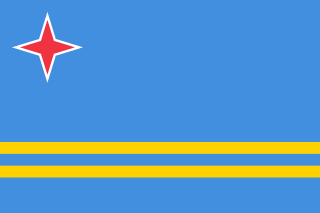
Aruba, officially the Country of Aruba, is a constituent country of the Kingdom of the Netherlands physically located in the mid-south of the Caribbean Sea, about 29 kilometres (18 mi) north of the Venezuela peninsula of Paraguaná and 80 kilometres (50 mi) northwest of Curaçao. It measures 32 kilometres (20 mi) long from its northwestern to its southeastern end and 10 kilometres (6 mi) across at its widest point. Together with Bonaire and Curaçao, Aruba forms a group referred to as the ABC islands. Collectively, these and the other three Dutch substantial islands in the Caribbean are often called the Dutch Caribbean, of which Aruba has about one-third of the population. In 1986, it became a constituent country within the Kingdom of the Netherlands, and acquired the formal name the Country of Aruba.

The Netherlands Antilles was a constituent country of the Kingdom of the Netherlands. The country consisted of several island territories located in the Caribbean Sea. The islands were also informally known as the Dutch Antilles. The country came into being in 1954 as the autonomous successor of the Dutch colony of Curaçao and Dependencies. The Antilles were dissolved in 2010. The Dutch colony of Surinam, although it was relatively close by on the continent of South America, did not become part of the Netherlands Antilles but became a separate autonomous country in 1954. All the island territories that belonged to the Netherlands Antilles remain part of the kingdom today, although the legal status of each differs. As a group they are still commonly called the Dutch Caribbean, regardless of their legal status. People from this former territory continue to be called Antilleans in the Netherlands.
The Netherlands Antilles was an autonomous Caribbean country within the Kingdom of the Netherlands, which was formally dissolved in 2010.

Curaçao, officially the Country of Curaçao, is a Lesser Antilles island country in the southern Caribbean Sea and the Dutch Caribbean region, about 65 km (40 mi) north of the Venezuela coast. It is a constituent country of the Kingdom of the Netherlands. Together with Aruba and Bonaire, it forms the ABC islands. Collectively, Curaçao, Aruba, and other Dutch islands in the Caribbean are often called the Dutch Caribbean. It is the largest of the ABC islands in both area and population as well as the largest of the Dutch Caribbean.

Bonaire is a Dutch island in the Leeward Antilles in the Caribbean Sea. Its capital is the port of Kralendijk, on the west (leeward) coast of the island. Aruba, Bonaire and Curaçao form the ABC islands, 80 km off the coast of Venezuela. Unlike much of the Caribbean region, the ABC islands lie outside Hurricane Alley. The islands have an arid climate that attracts visitors seeking warm, sunny weather all year round. Bonaire is a popular snorkeling and scuba diving destination because of its multiple shore diving sites and easy access to the island's fringing reefs.
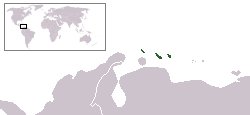
The ABC islands is the physical group of Aruba, Bonaire, and Curaçao, the three westernmost islands of the Leeward Antilles in the Caribbean Sea. These have a shared political history and a status of Dutch underlying ownership, since the Anglo-Dutch Treaty of 1814 ceded them back to the Kingdom of the Netherlands, as Curaçao and Dependencies from 1815. They are a short distance north of the Falcón State, Venezuela. Aruba and Curaçao are autonomous, self governing constituent countries of the Kingdom of the Netherlands, while Bonaire is a special municipality of the Netherlands. Territories of the Kingdom of the Netherlands, the countries, and its special municipalities, are outside the European Union; citizens have Dutch nationality and the former colonial power benefits from preferential trade, mineral and natural resource rights, particularly offshore.

Flamingo International Airport, also called Bonaire International Airport, is an international airport located near Kralendijk on the island of Bonaire in the Caribbean Netherlands. It was once the hub for BonaireExel and CuraçaoExel before they were rebranded as Dutch Antilles Express, and served as a secondary hub for Dutch Antilles Express and Insel Air. The airport is the fourth largest in the Dutch Caribbean, after Queen Beatrix International Airport on Aruba, Princess Juliana International Airport on Sint Maarten and Curaçao International Airport on Curaçao and is now the largest airport in the Caribbean Netherlands, with F. D. Roosevelt Airport in Sint Eustatius being the second largest and Juancho E. Yrausquin Airport in Saba being the smallest.

Schunck is the name of former fashion house and department store Firma Schunck in Heerlen, the Netherlands. It is also the name for the collection of buildings the firm has been housed in, one of which is known as the Glaspaleis, which is now a cultural centre and declared one of the 1000 most important buildings of the 20th century by the Union of International Architects.

The Netherlands Antillean guilder is the currency of Curaçao and Sint Maarten, which until 2010 formed the Netherlands Antilles along with Bonaire, Saba, and Sint Eustatius. It is subdivided into 100 cents. On 1 January 2011, in the islands of Bonaire, Saba and Sint Eustatius, the guilder was replaced by the United States dollar. In Curaçao and Sint Maarten, the Netherlands Antillean guilder was proposed to be replaced by a new currency, the Caribbean guilder, but this was stalled indefinitely by negotiations over the establishment of a separate central bank for Curaçao. In November 2020, the Central Bank announced the introduction of the replacement guilder, which was planned to be implemented in the first half of 2021; however, implementation was delayed several times.
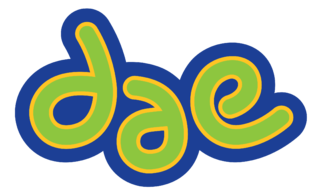
Dutch Antilles Express B.V. was an airline of the Dutch country of Curaçao. It operated high-frequency scheduled services in the Dutch Caribbean to United States, Dominican Republic, Colombia, Haiti, and Suriname. Its main base was at Curaçao International Airport.

The Netherlands Antilles was an autonomous Caribbean country within the Kingdom of the Netherlands. It was dissolved on 10 October 2010.

The Kingdom of the Netherlands, commonly known as simply the Netherlands, is a sovereign state and constitutional monarchy with 98% of its territory and population in Western Europe and with several small West Indian island territories in the Caribbean.
The economy of the Northern Mariana Islands benefits substantially from financial assistance from the United States and tourism. The rate of funding has declined as locally generated government revenues have grown. An agreement for the years 1986 to 1992 entitled the islands to $228 million for capital development, government operations, and special programs. Since 1992, funding has been extended one year at a time. The Commonwealth received funding of $11 million for infrastructure, for FY96/97 through FY02/03, with an equal local match.:]

EZ Air is a small regional service airline and Air Ambulance provider BES, founded in May 2000. Is based in Bonaire, with ticket offices in Bonaire and Curaçao.

The Caribbean Netherlands are the three public bodies of the Netherlands that are located in the Caribbean Sea. They consist of the islands of Bonaire, Sint Eustatius and Saba, although the term "Caribbean Netherlands" is sometimes used to refer to all of the islands in the Dutch Caribbean. In legislation, the three islands are also known as Bonaire, Sint Eustatius and Saba or the BES islands. The islands are currently classified as public bodies in the Netherlands and as overseas countries and territories of the European Union; thus, European Union law does not automatically apply.
Evelina Betancourt-Anthony is an Aruban-born Bonairean health administrator and politician. From 1 December 2015 she has served as the Deputy Lieutenant Governor of the island and in the absence of the Island Governor fills the duties of that office.
Prostitution in the Dutch Caribbean is legal and regulated. At least 500 foreign women are reportedly working in prostitution throughout the islands. Bonaire, Sint Eustatius, and Curaçao are sex tourism destinations.
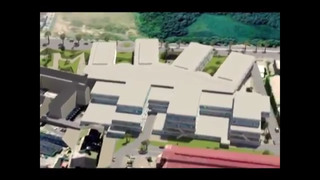
The COVID-19 pandemic in Curaçao is part of the ongoing global viral pandemic of coronavirus disease 2019 (COVID-19), which was documented for the first time in Curaçao on 13 March 2020. The case was a 68-year-old man who was on vacation from the Netherlands. By 9 July 2020, all cases resolved. On 15 July, a new case was discovered, and on 6 August all cases resolved again briefly until 10 August.
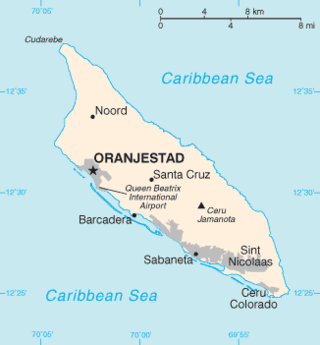
The COVID-19 pandemic in Aruba is part of the ongoing global viral pandemic of coronavirus disease 2019 (COVID-19), which was documented for the first time in Aruba on 13 March 2020. As of 29 May, all cases recovered. On 29 June, two new cases were discovered.

The COVID-19 pandemic in Bonaire is part of the ongoing global viral pandemic of coronavirus disease 2019 (COVID-19), which was confirmed to have reached the Dutch Caribbean island of Bonaire on 16 April 2020. On 28 April, all cases recovered. On 14 July, two new cases were discovered. On 13 August, all cases recovered.
This article is based on an extension of the 1966 M.A. thesis by drs. Christine W.M. Schunck.















